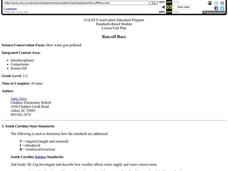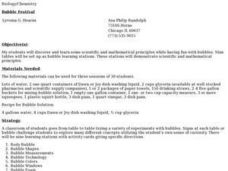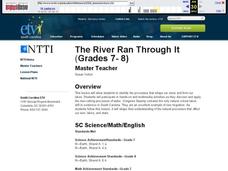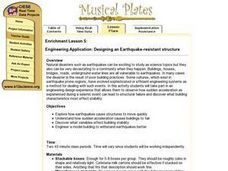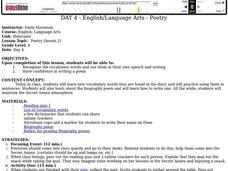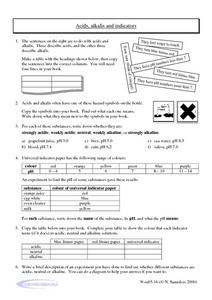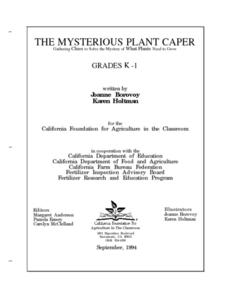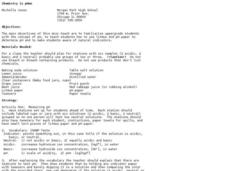Texas State Energy Conservation Office
Nuts! Calculating Thermal Efficiency
Oh nuts! Do macadamias or almonds produce more thermal energy? Energy enthusiasts find out with this experiment. The objective is to demonstrate to your class how the chemical energy contained in foods can be converted into useable...
American Chemical Society
Comparing the Amount of Acid in Different Solutions
Upcoming chemists use chemical reactions to determine relative pH in two different acids. This is a terrific lesson for middle schoolers that can stand alone as a practice in precision and lab skills, or as part of the unit on chemical...
Curated OER
Dissolving Salt
Fifth graders, in groups, complete an experiment/activity in which they dissolve salt in a cup of hot water and then observe what happens as the water evaporates over the next few weeks.
Curated OER
Grow Your Own Grub
Students study plant needs and growth by completing a gardening activity. In this plant study lesson, students watch a video and discuss plant growth needs. Students plant seeds in containers and water the plants. Students take photos of...
Curated OER
Run-off Race
Pupils create wetland models in pans and use them to experiment to see how plants help slow the flow of runoff water and keep our waterways clean.
Curated OER
Voil! C'est La Magie De La Chimie
Students examine chemistry and demonstrate the relevancy of it in their everyday world. In this chemistry lesson students complete a lab activity.
Curated OER
Bubble Festival
Students practice scientific inquiry while learning about bubbles. For this lesson about bubbles, students explore characteristics of bubbles. Students move through nine different "bubble" stations following directions and completing an...
Curated OER
Observing Osmosis
Students investigate osmosis using egg cells with the shells removed. In this osmosis lesson plan, students remove the shell of an egg by letting it soak in vinegar for two days. They take measurements and observe the cell. They soak the...
Curated OER
Fizzy Pop
Fifth graders compare and identify variables that affect the rate of a chemical change using Alka-Seltzer, water, ice, and hot water. They time how long each variable takes to pop the canister into the air, and record the results on a...
Curated OER
What Makes a Habitable Planet?
Students list conditions necessary for humans to survive. They then mix yeast with a nutrient broth consisting of warm water and table sugar in a plastic bottle, capping it with a party balloon and compare the factors within the bottle...
Curated OER
Function of a Stem
Fourth graders perform an experiment to test the function of a stem. In this science lesson, 4th graders write a description of their investigations. Students also explain how the stem interacts with the rest of the plant. Students use...
Curated OER
The River Ran Through It
Students identify the processes that shape our rivers and form our lakes. They participate in hands-on and multimedia activities as they discover and apply the river-cutting processes of water.
Curated OER
Disposable Diaper Comparison and Mystery Powder Identification
Students investigate which diaper is the most absorbent. In this chemistry lesson, students calculate how much water is absorbed by diapers. They identify an unknown powder based on physical and chemical properties.
Alabama Learning Exchange
Light, Dry and Nutritious - A Look at Dehydrated Food
Fifth graders study dehydration and dehydration of foods. They measure the amount of water lost from fruits as they are dehydrated. They use desktop publishing software to design an advertisement for dehydrated fruit after researching...
Curated OER
Atoms and Molecules
You can use hands on and kinesthetic activities to teach abstract concepts, such as atom and molecule lessons.
Curated OER
Designing an Earthquake-resistant Structure
Students attempt to design and build the most stable "earthquke resistant" structure. They create model buildings and test them on a shake table to see which design holds up the best.
Curated OER
Holocaust
The Holocaust is the focus of this interactive poetry strategy. The classroom will be set-up to remind students of the Secret Annex, with a table, lamp, and various other props. Each participant will receive 3 Saltine crackers and...
Curated OER
Plate Tectonics
Learners participate in a series of experiments to learn about plate tectonics and the different materials of the Earth. In this plate tectonics lesson plan, students use eggs, water, beakers, paper, and more materials to learn about the...
Creative Chemistry
Acids, Alkalis and Indicators
In this pH instructional activity, learners describe acids and alkalis. They also determine whether substances are strongly acidic or alkaline. To determine the pH of given substances, learners use the color of universal indicator paper....
Curated OER
The Mysterious Plant Caper
Students investigate the basic parts of plant and that plants are living things which require water, air, light and nutrients for survival. They do this through a series of scientific experiements and multi-curricular hands-on activities.
Curated OER
Fizzies Virus
Sixth graders discover how disease spreads. In this disease control lesson, 6th graders brainstorm a list of diseases and simulate how a disease spreads by using cups of hydrogen peroxide and water. Students create the "Fizzies Virus"...
Curated OER
Understanding: Flight
Students review the principles of flight before performing a series of simple experiments. Working in small groups, they complete hands-on activities that demonstrate the principles that make it possible for an airplane to lift into air...
Curated OER
Chemistry is pHun
High schoolers investigate the pH of solutions and they learn how to use different types of indicators. In this pH lesson plan, students test various solutions with pH paper and determine if they are acidic, basic or neutral. They also...
Curated OER
Rock Candy Crystals
Students discover how rocks are created. In this rock formation instructional activity, students investigate saturation, evaporation, and phase changes in geology. Students create rock candy from skewers, string, boiling...




